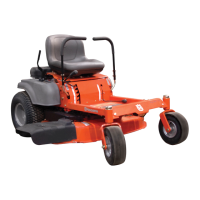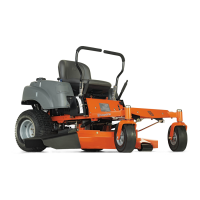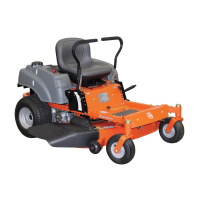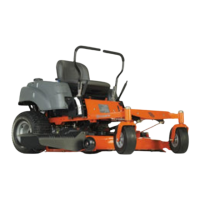Do you have a question about the Husqvarna RZ4216 and is the answer not in the manual?
Defines terms like left/right for the machine's orientation and driving direction.
Provides instructions and warnings for transporting the machine on public roads.
Advises on safe towing practices, including caution, turning, and stopping.
Specifies the intended use of the machine and general safety precautions.
Emphasizes the importance of specialized retail stores for support and service.
Explains where to find the machine's and engine's manufacturing numbers.
Explains the meaning of warning and information symbols used in the manual.
Illustrates and explains various operational and safety symbols.
Details specific safety symbols related to operator actions and warnings.
General safety advice and warnings about the cutting machine's capabilities.
Lists essential operating procedures and precautions for safe use.
Further safety guidelines for operation, including lighting, alcohol, and age.
Warns about hazardous chemicals in engine exhaust and carbon monoxide.
Lists necessary personal protective equipment for safe operation.
Provides critical safety advice and precautions for operating on slopes.
Details safety measures to prevent accidents involving children.
Provides detailed instructions for safe refueling and handling of gasoline.
Warns about the hot engine and exhaust system and the risk of burns.
Outlines essential maintenance tasks and safety precautions.
Alerts users to hazards associated with lead-acid batteries.
Advises on avoiding electrical sparks and battery hazards during maintenance.
Recommends regular cleaning of the deck and components.
Gives instructions for safely transporting the machine.
Provides guidance and warnings for towing the machine.
Mentions the availability of a spark arrestor for the muffler.
Identifies and labels the various controls on the machine.
Explains the operation of the dual steering controls for speed and direction.
Details the operation and importance of the parking brake.
Explains how the throttle control regulates engine speed and blade rotation.
Describes the function of the ignition switch for starting and stopping the engine.
Explains the use of the choke control for cold engine starts.
Provides instructions and warnings for refueling the machine.
Describes the location and operation of the fuel shut off valve.
Explains the function of the lifting lever for deck height adjustment.
Advises on checking tire pressure for proper tracking.
Details how to engage and disengage the mower blades.
Explains how to engage bypass linkages for manual transport.
Offers advice for new users on operating zero-turn mowers.
Explains how to control the mower's direction and speed.
Lists checks and conditions required before starting the engine.
Provides a step-by-step guide for starting the engine.
Continues the procedure for starting the engine, including throttle and choke.
Completes the engine starting procedure with ignition and fuel valve.
Details post-start engine operation and jump-starting procedure.
Explains how to release the parking brake and begin mowing.
Provides specific safety instructions for operating on slopes.
Offers advice for achieving optimal mowing results and maintenance.
Details the correct procedure for stopping the engine and securing the mower.
Provides a comprehensive schedule for routine maintenance tasks.
Continues the maintenance schedule and lists safety precautions before servicing.
Lists critical safety steps before performing any service or adjustment.
Covers battery maintenance, cleaning, and replacement.
Step-by-step instructions for replacing the mower battery.
Explains the safety interlock system for starting and operating.
Specifies the correct tire pressure for optimal performance.
Details checks and adjustments for the parking brake.
Guides on checking V-belts for wear and damage.
Instructions for removing and replacing the deck belt.
Provides steps for replacing the EZT belt.
Emphasizes blade sharpness, care, and replacement.
Details the procedure for replacing mower blades, including torque specs.
Outlines the process for adjusting the mower deck for even cutting.
Step-by-step guide to leveling the mower deck.
Covers checking and servicing caster wheels.
Provides instructions for cleaning the mower after use.
Advises on checking for loose or missing hardware.
Presents a schedule for lubricating various parts of the machine.
Offers general tips and warnings for lubrication.
Details lubrication for the front wheel mounts and bearings.
Refers to the engine manufacturer's manual for lubrication.
Describes lubrication for the steering control shafts.
Lists common causes for the engine failing to start.
Identifies issues preventing the starter from turning the engine.
Provides potential causes for the engine running unevenly or rough.
Lists reasons why the engine might lack power.
Explains common causes for engine overheating.
Identifies issues preventing the battery from charging.
Lists causes for the machine's slow or uneven movement.
Explains why the mower deck might not engage.
Lists factors contributing to uneven mowing results.
Provides reasons for excessive machine vibration.
Gives instructions for preparing the machine for long-term storage.
Advises on ordering parts and scheduling annual service.
Lists torque values for various fasteners.
Details engine manufacturer, type, power, lubrication, and fuel.
Outlines transmission type, controls, speeds, and brakes.
Lists front caster and rear tire details, including pressure.
Provides details on cutting width, height, blades, and output.
Lists the machine's weight and overall dimensions.
Explains requirements for labels and compliance in the USA.
Mentions vibration data and Declaration of Conformity for CE markets.
Lists checks to be performed during initial delivery service.
Outlines the initial service required after 10 hours of use.
Details the maintenance tasks for the 25-hour service interval.
Lists the maintenance procedures for the 50-hour service interval.
Outlines the maintenance tasks for the 100-hour service interval.
Details the comprehensive maintenance required for the 300-hour service.
Lists annual maintenance checks and replacements.
| Cutting Width | 42 inches |
|---|---|
| Transmission | Hydrostatic |
| Engine Power | 16 HP |
| Deck Material | Steel |
| Fuel Capacity | 3 gal |
| Turning Radius | Zero turn |











